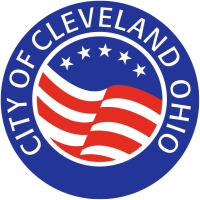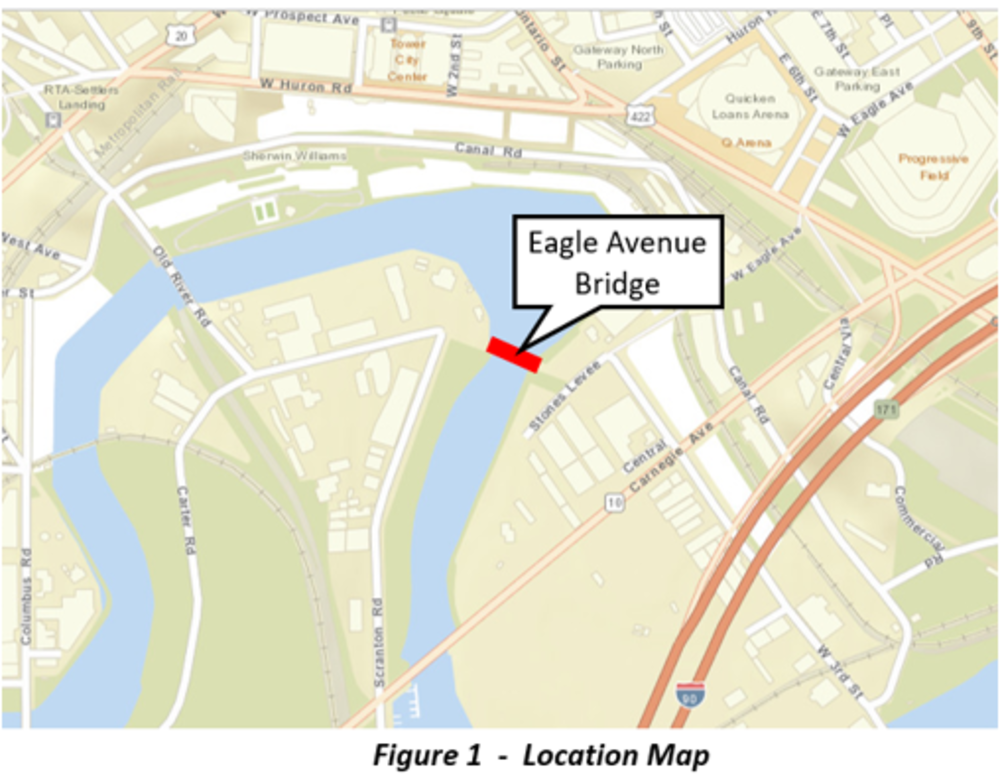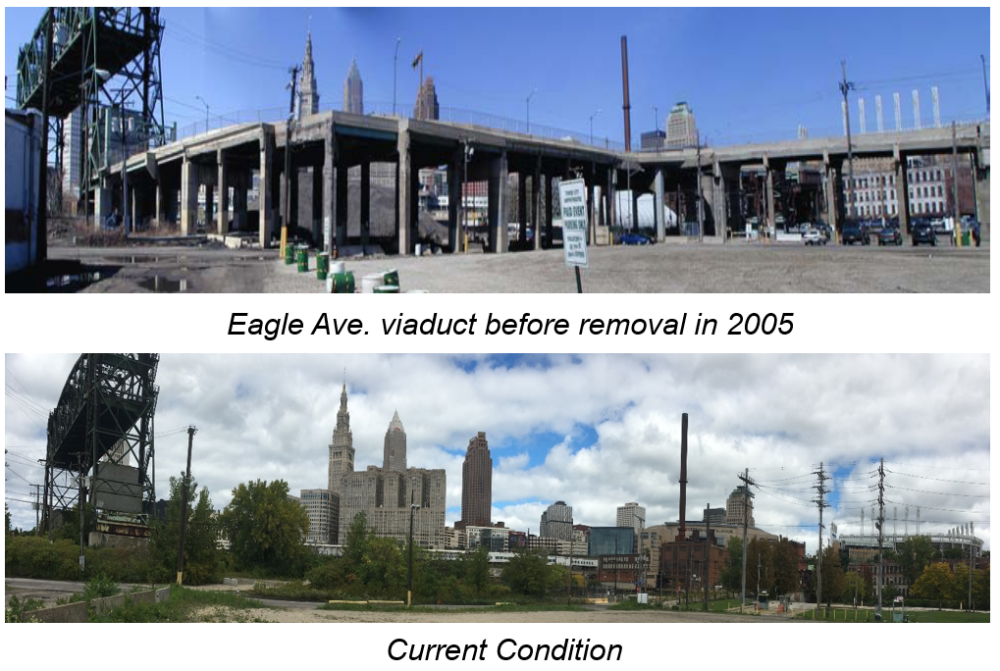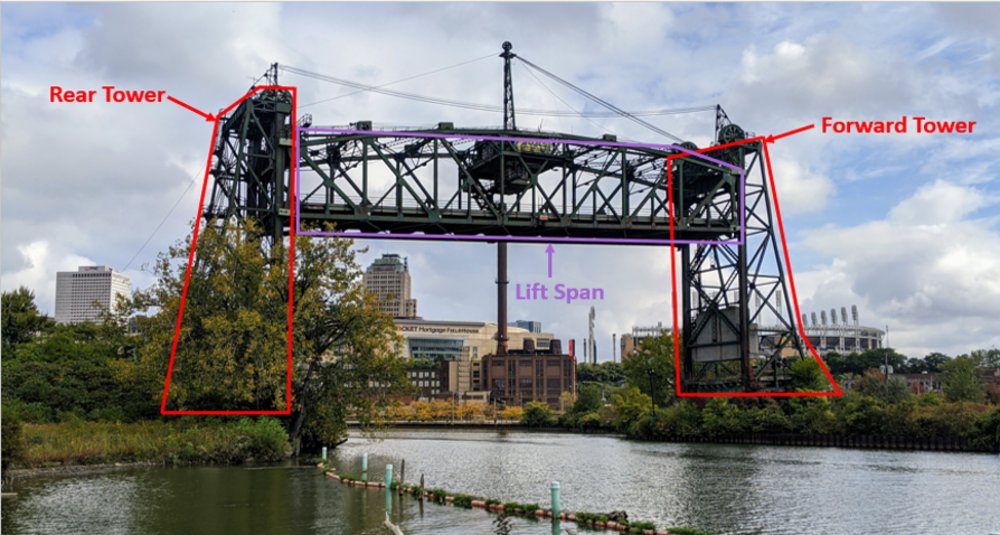CUY Eagle Avenue Bridge
CUY Eagle Avenue Bridge
Comment Responses Now Available
The first public meeting "virtual open house" was held from June 12, 2023 - July 14, 2023. Please see below for more details and information about the project.
Responses to all public comments are available to view and download under the "Documents" section located in the sidebar of this project webpage. Many comments received during the public meeting comment period were in favor of the preferred alternative (demolition of the bridge). The rest of the comments expressed their disagreement with the demolition option, mentioning certain reasons about the need for repairing or replacement of the bridge to meet the current development going on in the area. The City of Cleveland has reviewed the comments from the public and project stakeholders and found that moving forward with the preferred recommended alternative will be an effective measure to improve safety in the project area.
CUY- Eagle Avenue Bridge (PID 118527)
What is the project?
The City of Cleveland has developed and evaluated alternatives to address the structural deficiencies of the existing Eagle Avenue Bridge over the Cuyahoga River (SFN 1869604). The City of Cleveland and the Ohio Department of Transportation (ODOT) considered four alternatives: demolition, stabilizing the existing structure, removal/relocation, or replacing the historic bridge. Due to its poor physical condition and increasingly rapid deterioration, the City of Cleveland has determined that removing the existing bridge is the safest and most cost-effective alternative that satisfies the purpose of the project. Details on the alternatives and decision-making regarding the recommendation are provided in the blue tabs below.
Why is the project needed?
The bridge has structural deficiencies and poor physical conditions that are continuing to deteriorate, with evidence of trespassing and vandalism. The project is necessary to address the structural deficiencies of the bridge and related safety issues, while continuing to maintain long-term, safe river traffic below.
Why is public input needed?
The Eagle Avenue bridge is the first vertical lift bridge in Cleveland and has been determined to be eligible for listing on the National Register of Historic Places (NRHP). Because of the structure's historic significance, the City of Cleveland is seeking consulting parties to participate as removal of the bridge moves forward in the project development process.
Section 106 of the National Historic Preservation Act of 1966 requires Federal agencies to consider the effects of their actions on historic properties. The NHPA created the Advisory Council on Historic Preservation (ACHP), primarily to ensure Federal agencies consider historic preservation concerns throughout project planning. Section 106, the implementing regulations of the NHPA codified at 36 CFR Part 800, requires the Federal agency official to consult with other parties with an interest in the effects on historic properties. Section 106 defines other parties as Consulting Parties. The Section 106 process, used by ODOT for projects like this one, seeks to incorporate historic preservation values into project planning through consultation with the agency official and Consulting Parties.
In addition to seeking consulting parties, the City of Cleveland is also seeking comments on the project alternatives, impacts, and any other questions or concerns the public may have.
How can I participate/provide comments?
Please review the project information below. Navigate to the "Become a Consulting Party" if you’d like to apply to become a consulting party. Navigate to the “Comments” section to submit any comments or questions you may have.
Questions and comments about the project can also be submitted by the following methods.
- Email: rmason@clevelandohio.gov
- Mail a comment form (located for download in the sidebar of this webpage) or letter to:
City of Cleveland - Division of Engineering & Construction
Attn: Ron Mason
601 Lakeside Avenue, Room 518
Cleveland, Ohio 44114-1015
Comments may be submitted until Friday, July 14, 2023.
Thank you! We look forward to hearing from you.
History
The Eagle Avenue Bridge (SFN 1869604) was originally constructed in 1930 - 31 and was a component of the Eagle Avenue Viaduct built in 1928. The viaduct provided automobile and pedestrian crossing over the Cuyahoga River freight channel. (See Figure 1).
The Eagle Avenue mechanical lift bridge operated so that automobiles and other vehicles were able to cross the Cuyahoga River (when lift was “down” level with the roadway) while also maintaining access for goods to travel along the river (under the bridge, when the lift was “up”) to the Flats area of the Cuyahoga River. The bridge consists of two towers and a central 224’ lift span. The lift span is a through Pennsylvania (Petit) truss. An operator house is situated in the center of the lift span. The bridge was the first vertical lift bridge built in the City of Cleveland and is eligible for listing on the National Register of Historic Places (NRHP).
The bridge was rehabilitated in 1991. ODOT removed most of the Eagle Avenue Viaduct in 2005, leaving the lift bridge in place. The bridge is no longer in service and has been retired in the “up” position per U.S. Coast Guard requirements to allow freighter passage below. In addition to the freighter traffic, the Cuyahoga River near Eagle Avenue is used by recreational boaters and rowing crew teams.
Once the Eagle Avenue Viaduct was removed and the Eagle Avenue bridge was not serving a transportation purpose, it was decided that maintenance funds would be reallocated to the 5 other National Register (eligible or listed) lift bridges in Cleveland. Therefore, the bridge has not been maintained since the closure in 2005. The lack of maintenance has led to the deterioration in the structure of the bridge and the current critical condition. The most recent bridge inspection, conducted in October 2021, rated the structure as in Critical condition and found severe corrosion and other structural deficiencies.
Several alternatives were explored to address the structural deficiencies of the bridge. After evaluating the alternatives, it was recommended that removing the existing bridge is the safest and most cost-effective alternative that satisfies the purpose of the project.
You can learn more about this evaluation and recommendation by watching the video in the next tab (“Alternatives and Recommendation”).
Purpose & Need
The existing bridge has not been functioning since the closure in 2005. Maintenance funding prioritized the other 5 lift bridges in the City that served a transportation purpose. No maintenance has been conducted on the structure since 2005. Lack of maintenance, structural deficiencies, and associated safety issues could lead to a potential bridge collapse which could endanger lives and the movement of commercial traffic below. The purpose of this project is to address the bridge’s deficiencies and the resulting safety concerns.
Bridge Components
(Click image to enlarge)



